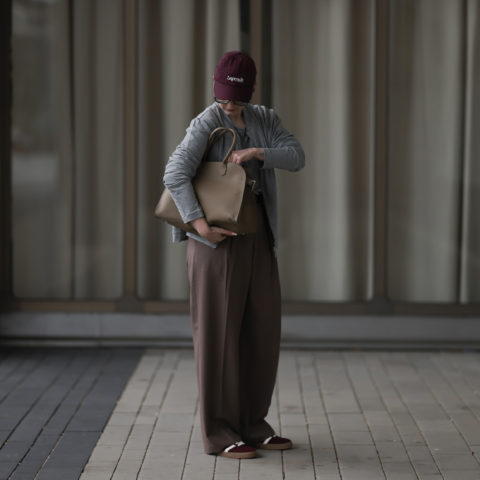Passage to India: We tour Rajasthan with Holt Renfrew in search of one-of-a-kind treasures
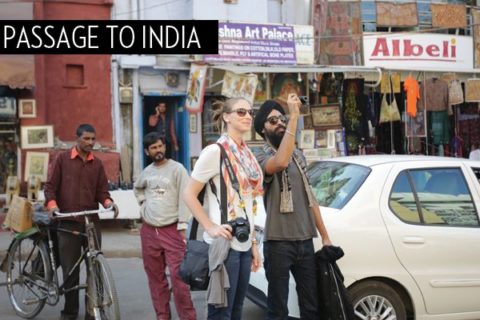

In the age of the selfie, Waris Ahluwalia is the world’s most reluctant subject. In Gap ads and New York social diaries, the actor/jewellery designer appears deadpan and remote. But travelling with him in his native India, I discover a cheerful, easygoing guy with a deep appreciation for handmade things. It’s a passion he shares with Alexandra Weston,
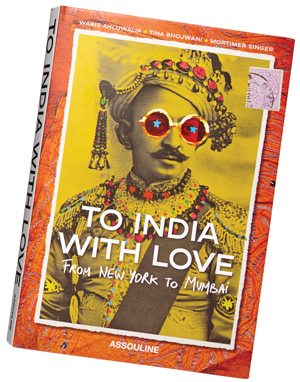
Read on to discover our journey through India:
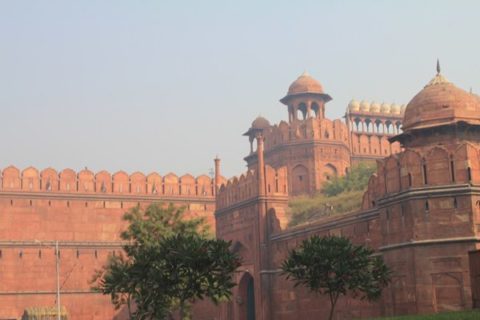
Day 1
After a breakfast of mango yogourt and Assam tea at The Imperial Hotel, we venture out into the rubble of Delhi. Rusted-out trucks and open-air tuk tuks buzz through the streets. Women in vivid blue and yellow saris step around the dogs, goats and cows dozing on the crumbling sidewalks. It is hard to tell what’s under construction in this city of 22 million, and what’s just falling apart.
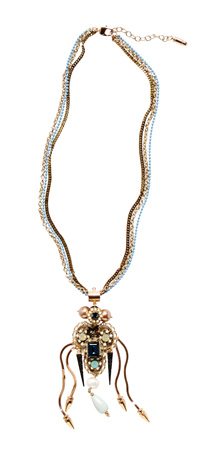
Amid the maze of stalls in Khan Market, Noelle Kadar, a New York design consultant who now lives in New Delhi, leads us to a few charming local designer shops we never could have found on our own. Each sweetly decorated space is a bizarre contrast to the tangle of electrical wires and rotting garbage just outside. (We later learn that everyone shovels their garbage into the road so the roaming animals are fed.) The exquisitely embroidered pillows at Sarita Handa, delicately tasselled scarves at Anupamaa and spiky crystal and pearl pendants at Second Floor Studio demonstrate a level of care and sophistication that is not evident on the streets. This is our first hint of the seductively confounding nature of India.
GPS turns out to be of limited use in a city short on street names. After driving in circles, we finally locate Swiss designer Liane de Selys’s studio, Joli. Weston zeroes in on the seamless leather wallets and keychain tassels. “I love the red/burgundy colour combination,” she says. After a lunch of
poutine and French onion soup at Chez Nini (a spot owned by a Quebec expat), we head off to Hauz Khas market. Kadar leads us through the decrepit winding hallways to yet another impossible-to-find-without-a-guide shop, Annaikka. There, we fall in love with what Kadar calls “badass traditional Indian design.” I leave with a leather harness covered in metal shards and chains, but I could have bought everything I saw.
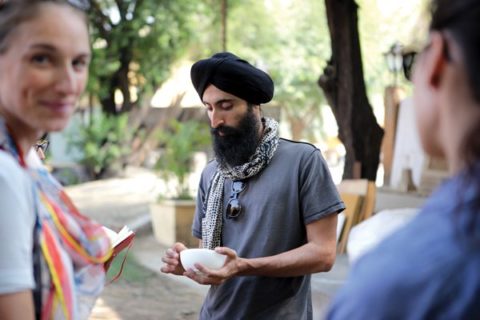
Day 2
We have a 4 a.m. wake-up call for a flight to Udaipur, known as the Venice of India. Speeding from the airport to breakfast in the countryside, we pass men bathing in pools of water, women transporting jugs on their heads, families living under roadside tarps and motorcycles whizzing by carrying women wound up in pink or blue saris, with only their eyes exposed. Every second is a visual feast. At The Royal Retreat, we tuck into masala omelettes and watermelon juice, then we are led to the adjacent workshops, where House of Waris wood and marble pieces are made. The craftsmen (they are all men) pray to Vishvakarman, god of carpenters, before picking up their tools. Weston and Ahluwalia inspect the first sample of a marble and lapis bowl that will be sold at Holt’s.

We check into our hotel, the former guesthouse of the royal palace next door, then walk downhill into the nerve-jangling madness of the town. Up a disintegrating staircase, we reach the home and studio of the recently deceased Dr. Abdul Majeed, a renowned batik artist. His teary widow unfolds his masterworks, complex illustrations with more than 50 shades of dye, before taking us up a periwinkle blue staircase to witness the production of a House of Waris scarf. The artists, including Majeed’s daughter, are crouched around tubs of beeswax, drawing Ahluwalia’s dove designs onto white silk. On the rooftop, the fabric is dipped in trays of dye, then sticks of wood are lit campfire-style under a pot of water to wash off the wax. Each step of the ancient process is done with so much care, I start to wonder how such order can thrive amid the chaos outside.
Back at the hotel, my body is screaming for sleep. When I get to my room, I hear the blaring of trumpets. I throw open the drapes and find an elephant dressed in gold and a wedding party dancing in the streets. Fury turns to joy, and I fall asleep with a smile.

Day 3
I am in the passenger seat of an SUV on the highway to Jaipur, and a truck is coming straight toward me. There are no bridges or overpasses, so travelling the wrong way on the highway turns out to be normal. It’s the first of many times we will narrowly avoid a head-on-collision. We pass tasselled camels, painted cows, a hotel called Decent that resembles a bombed-out gas station and a turbaned man
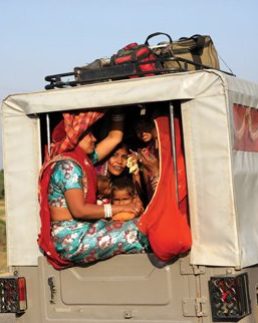
perched like a bird on a post. After driving for nearly seven hours, we pull into Ratan Textiles, an expert block-printing studio producing candy-coloured caftans, scarves and linens in swirling geometric prints. Weston and Ahluwalia discuss colours for a custom order of tiger-print bedsheets while I shop for embroidered napkins and beaded beach tunics.
Exhausted again, we pass through a metal detector at the Taj Rambagh Palace, the former residence of the maharajah of Jaipur. Greeters shower us with rose petals, drape us in marigolds and smudge red powder on our foreheads. This will be our glorious home for the next three nights. My opulent room is truly fit for a princess; it overlooks the ornamental gardens, where a young man stands all day, shooing pigeons with a white flag. At dinner in an old steam engine, we find a pizza named Toronto and topped with Canadian bacon on the menu. Could this day get any more surreal?
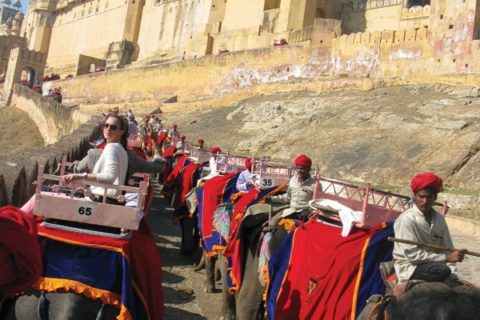
Day 4
Feeling queasy after a post-breakfast elephant ride, we pull up to the elaborate blue floral façade of the Woolen Carpet Factory, run by the fourth-generation owners. The 77-year-old sample maker, who lives upstairs with the family, sits crouched under a log contraption, proud to still be knotting yarn. Weston and Ahluwalia are having trouble choosing from a variety of flat weave carpets. The problem? They are all stunning. It’s another example of order amid chaos. Or is there an order in this country that I can’t see?

Next, we drive to the carpet maker’s dye house, which is, in fact, a home on a dirt road. An adorable two-year-old and his veiled young mother smile bashfully at us from a doorway as we stand in their courtyard observing men stomping on wool in a sudsy vat, twisting yarn around a post to squeeze the water out and dipping it into a tub of indigo dye. The skeins are then hung across bamboo rails on the roof to dry. If there is no sunlight, there is no dyeing that day, we are told, because the colour won’t be right.
After a quick bite at a café promising “safe” salads, we return to Ratan Textiles to supervise the block printing of Ahluwalia’s pocket kerchiefs. Beside us, an Italian designer is agonizing over a complex pattern of dots and squiggles.
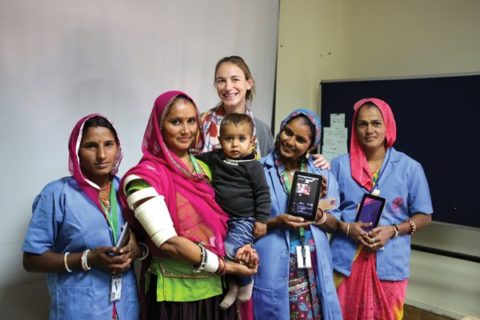
Day 5
A UNICEF team has joined us for breakfast to tell us about its health and education programs. They are encouraging girls to stay in school beyond age 10 or 12, which is when they often leave to look after younger siblings and find a groom. We visit a school and meet 11-year-old Priyanka Kumari, who is the first person in her family to attend school. English is her second language, yet she is adept enough in it to move me to tears with her poem:

Only a word can free a thought
From its prison behind your eyes.
Maybe your mind is holding now
A marvellous new surprise.
Next, we meet a group of pre- and post-natal health counsellors called ASHAs who have travelled 14 hours from the desert. They are draped in silk with thick cream bangles from elbow to shoulder, worn to signal weight loss or gain. Primitive as this may sound, the women are also equipped with digital tablets and new software that helps them identify high-risk pregnancies. “What do you need to do your work better?” Weston asks. “More tablets,” they reply through an interpreter. Back in the car, Weston starts devising a special H Project give-back program.
While at lunch at Rambagh Palace, I spy an enormous red Birkin across the lawn. It’s being carried by Sharon Stone’s butler, who is walking several paces behind her. Later, we discover that we are all heading to the same place—Gem Palace, once the court jewellers to the Mughal emperors. But we beat Stone there and are taken upstairs to the office of Siddharth Kasliwal, a longtime friend of Ahluwalia’s. “Let’s have some fun,” Kasliwal declares, and his assistants start draping us in diamond collars and forehead pendants. Many of the designs are by his father, Munnu, who passed away last year but whose joyous spirit lives on in extravagances such as a 42-carat sapphire ring that opens to a pile of loose rubies. Kasliwal also pulls out his own bejewelled wedding turban. All he needs now is the bride (he receives piles of “resumés” every month). We play for three hours, during which time Ms. Stone has come and gone downstairs.
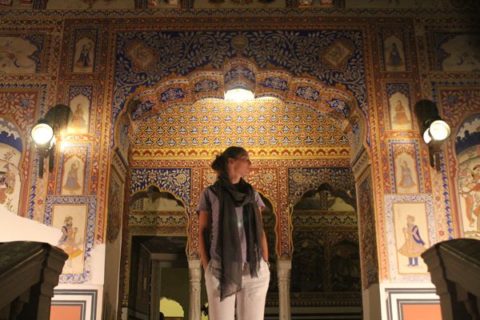
Day 6
Back in Delhi, our trip is nearing its end and I am no closer to comprehending India’s curious contradictions. On our way to dinner, Ahluwalia, a devout Sikh, says something that helps: “In the Sikh

religion, there is the idea of spirituality existing within chaos. Not on a mountaintop, not in a retreat, but within chaos. I don’t need to show you beauty and magic in a forest; it’s there. You don’t create an oasis in the middle of an oasis. You create an oasis in the middle of chaos. That’s when your humanity is tested, that’s when your spirituality is tested. That’s when you’re put to your best.” We pull into the driveway of Bukhara, Delhi’s finest restaurant, for our last group meal. A guard approaches to inspect our trunk for explosives. But now I get it. So bring on the chaos.


